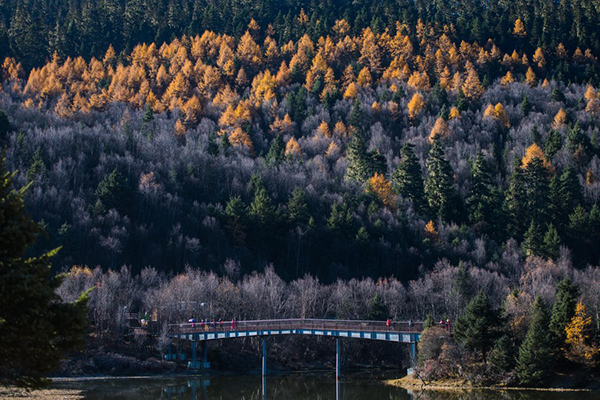【新华社】China's leading seed bank preserves plant biodiversity

Photo taken on Nov. 6, 2019 shows a view of the Potatso National Park in southwest China's Yunnan Province. (Xinhua/Hu Chao)
KUNMING, Oct. 9 (Xinhua) -- Chinese scientists have recently collected seeds of several plants at a height of about 6,200 meters on Mount Qomolangma and will permanently preserve them in a place where seeds can be kept alive for as long as thousands of years.
The seed haven, namely the Germplasm Bank of Wild Species, is located in an ordinary four-story building in a research institute in the city of Kunming, which will host the upcoming 15th meeting of the Conference of the Parties to the UN Convention on Biological Diversity (COP15).
As the genes of most plants are contained in their seeds, germplasm resources have become the carriers of plants' genetic information. A seed bank serves as the most important facility for preserving such resources.
The Germplasm Bank of Wild Species had preserved more than 85,000 seed samples from over 10,000 species of wild plants by the end of 2020, accounting for 36 percent of the number of China's seed plant species, said Yu Fuqiang, deputy director of the bank.
A "NOAH'S ARK"
The discovery of a peculiar wild rice species by Yuan Longping, a globally renowned agronomist, in the southern island of Hainan in 1970 became the prelude of China's decades of hybrid rice research.
However, the fate of wild rice is worrying, said Li Dezhu, director of the germplasm bank. Take Yunnan Province as an example. In the 1980s, there were wild rice populations in 26 places in Yunnan, but now they have disappeared in all but two locations.
The rapid loss of biodiversity and germplasm resources is the main reason for the establishment of seed banks around the world. Construction of the germplasm bank in Kunming, the capital of Yunnan, started in 2004, and it was put into operation three years later. It includes seed pool, DNA bank, microbial bank, animal germplasm resource bank and other sectors.
"Wildlife germplasm resources have great application potential in the biological industry, attracting global attention, especially for the collection and preservation of wild plants," said Yu.
Currently, seeds can only be accepted by the Germplasm Bank of Wild Species if they tick at least one of three boxes: endangered, endemic or "of economic importance."
The long-term conservation of a seed is a complex procedure, involving more than 70 steps at the end of which the seed will be stored at minus 20 degrees Celsius. If properly stored, the seed could theoretically stay alive for decades or even thousands of years.
In order to make sure the seeds remain viable, scientists "wake up" some of the seeds from their dormancy every five to 10 years. "We take some samples and test their ability to grow," said technician Yang Juan with the bank.
SOWING SEEDS OF HOPE
The Germplasm Bank of Wild Species has established a germplasm resources collection network involving dozens of domestic scientific research institutions, universities and nature reserves. They have also formulated seed collection codes and standards.
The bank also worked closely with its international counterparts for seed safety duplication storage, which is necessary to ensure the safety of global germplasm resources, Li said.
"When a species is destroyed by natural disasters like fires, frost and plagues of pests, or other catastrophes, we will activate these seeds and revive the species," he added.
Seed collectors have left their footprints across the country ranging from deserts and tropical rainforests to plateaus. To ensure genetic diversity, they have to collect seeds of the same plant in different places. At least 2,500 seeds will be collected and preserved for each plant, according to Cai Jie from the germplasm bank.
When collecting seeds, researchers record the time, place, altitude, soil type, surrounding environment and other information, which will serve as the basis for future ecological restoration.
"Seeds are life and hope. I hope we can better protect the future of humanity through protecting germplasm resources," Li said.
(新华社 2021年10月9日)
来源:https://xhnewsapi.xinhuaxmt.com/share/news_pc?id=616641754320896&showType=3002&utdId=YU7//DDUVCcDAIC4f5wzOguS&version=2.5.4
